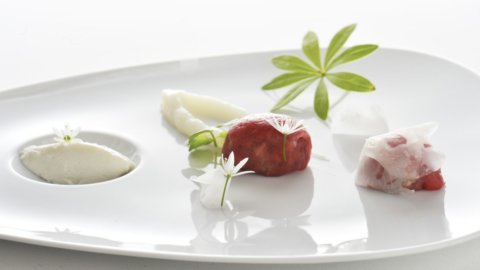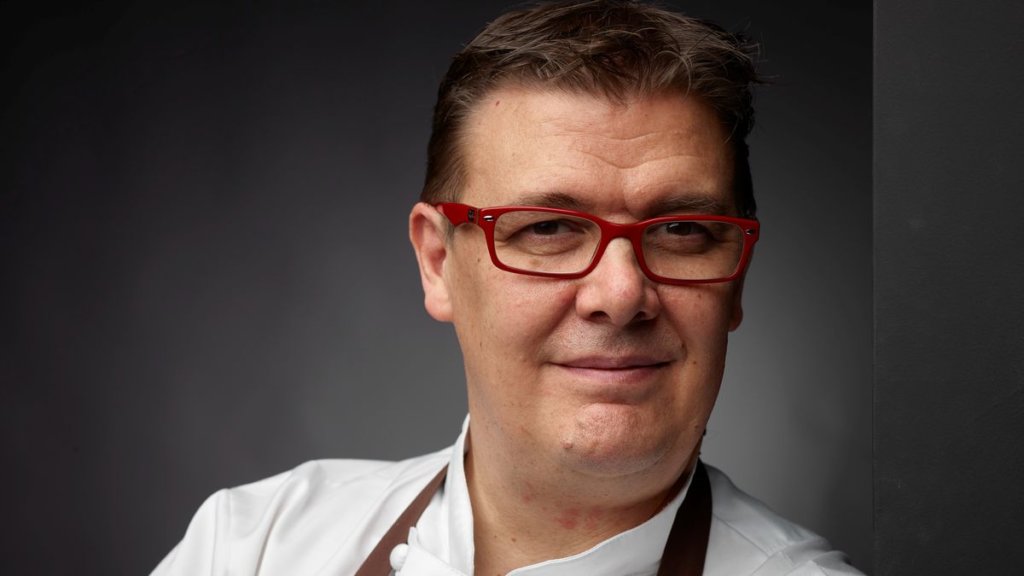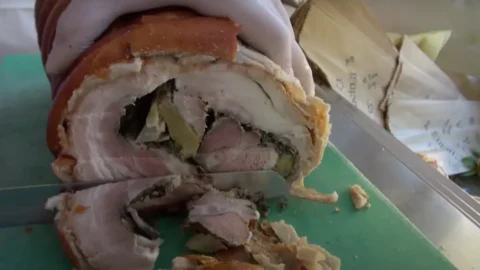“A sensory journey along a 7 or 13-course tasting menu: inebriated by the intense flavors of game, tasty river fish, particular cheeses and a rare selection of botanical elements, interesting in terms of variety and complexity. You will therefore get to know a cuisine – technical and creative – that brings the Dolomites and the forest to your plate. With a culinary culture acquired in the kitchens of starred maisons (Adrià and Ducasse, just to name a couple), a little chef, a little artist, Alessandro will welcome you in one of the most romantic restaurants in the region: 5 tables within the walls of a 600th century mill in a succession of galleries and wooden decorations among the ancient millstones”. Thus the Michelin Guide, which awarded him a prestigious star, introduces the gourmet reader to the enchanted mountain of Alessandro Gilmozzi, chef and patron of the El Molin restaurant in Cavalese in Val di Fiemme.
Witness of a family that has been running restaurants for generations in these valleys Alessandro Gilmozzi, born in 1965, opened his restaurant thirty years ago in a 1600s mill, massive stone walls and old wood, with the ambition of attesting to his own philosophy, which it is based on a constant search for flavors that only the mountains can and can offer, for the traditions of the Trentino area, for the atavistic peasant wisdom of local producers, and which aims to establish a new tradition.
Filtered, that is, through the fundamental experiences acquired by giants of modern world catering such as Ferran Andrià, father of molecular cuisine, the former dishwasher of the Playafels hotel in Castelldefels that from the "El Bulli" restaurant in Roses on the Costa Brava, has climbed the heights of great international cuisine to the point of obtaining 3 Michelin stars and positioning itself first in The World's 50 Best Restaurants ranking. Or like Alain Ducasse Monarch chef of the legendary Le Louis XV, inside the Hotel de Paris in Monaco, of the Alain Ducasse of Paris of Jules Verne on the Eiffel Tower, at the head of the group that bears his name and which, with 1400 employees, controls 20 restaurants in various countries, called to collaborate with the European Space Agency for the development of the most suitable foods for astronauts, succeeded in the remarkable feat of managing three Michelin 3-star restaurants simultaneously in three different countries, having obtained 21 in his long career.
Starting from these granite bases, Alessandro Gilmozzi has never stopped experimenting with original raw materials, such as lichens, mosses, resins, roots and wild herbs or perfecting recipes of the memory that have the scents of smokes, herbs from the woods, wildlife, and he is so imbued with this culture that the speck he uses in his cooking is personally prepared according to the old traditions of the local people, personally picking the herbs he needs in the woods, just as he is the jealous guardian of his juniper-flavored alpine butter .
As he often likes to repeat, his cuisine is from the Dolomites («Living in an area like that of the Trentino Dolomites, it is enough to open the window to get sources of inspiration. The mountains, the air we breathe, the woods and the wonders of which gives us a gift every day, their variety at every change of season") strongly rooted in the meadows, woods and rocks of its mountains, lovingly transmitted to its customers through innovative processes and long-meditated research both in low-temperature cooking, both in the combinations and in the use of smoking and the old culinary methods of the people who have always inhabited these extraordinary places. And it is thus that in her dishes this whole world takes shape in the eyes like postcards of a landscape of a world of perfumes, flavors and atmospheres.
The recipe proposed by the Chef, "Biddle of ciuiga, turnip mayonnaise and wild garlic ice cream", can be considered a synthesis of his culinary philosophy that marries tradition and innovation. The protagonist is the Ciuiga. In the local dialect the word ciuiga indicate pine cones of the fir trees, but this name has also been transferred due to the elongated shape to a cured meat of humble origins that comes from stories of extreme poverty of the external Giudicarie. area of western Trentino between Lake Garda and the Brenta Dolomites. In 1875, in a time of great economic difficulties, Palmo Donati, a butcher from the town of San Lorenzo in Banale, thought of recovering the less noble parts of the pig, those that could not be sold, by grinding them and mixing them with a widespread local ingredient, the turnip . This tradition has been recovered over time. Today for Ciuiga, a Slow Food presidium, the best parts of the pig are also used (shoulder, neck, belly, throat) and a lower percentage of turnips (35-40%).
The recipe: Biscuit of ciuiga, turnip mayonnaise and wild garlic ice cream
Ingredients for 10 people:
1 kg of ciuiga
50 gr of cornstarch
500 g of fresh turnips
Extra virgin olive oil to taste
130 g of minced wild garlic
5 cloves of garlic (without core)
1,5 lt of latte
200 grams of cream
70 g of eggs
30 g of sugar for the eggnog
Procedure:
Form small morsels with the ciuiga, to take with your hands and wrap them in slices of turnips. With other turnips make a juice using the centrifuge and we're going to make a false mayonnaise: bring the juice to 40°C, add the cornstarch mixing with a whisk and then bring to 70°C.
Remove from heat and whip with extra virgin olive oil.
For the ice cream, divide the milk into three and blanch the garlic three times, each time in a different milk. The milk that is used for the third time can be used to make ice cream to which cream and minced wild garlic will be added. Also add the previously made hot zabaglione. Freeze the ice cream by putting it in an ice cream maker.
Compose the dish by making a mirror of mayonnaise on which to place the morsel of ciuiga and a quenelle of ice cream.
El Molin restaurant
Piazza Cesare Battisti, 11
38033 Cavalese (TN)
Tel. 0462 340074
www.alessandrogilmozzi.it
info@alessandrogilmozzi.it






